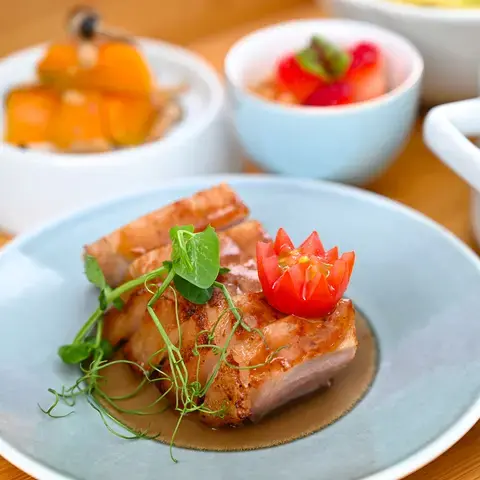When the Michelin Guide Singapore live-streamed its restaurant selection in a virtual awards ceremony in September 2021, the famed Hawker Chan founded by Chan Hong Meng was noticeably missing.
Most Singaporeans did not bat an eyelid over Chan’s stark absence. I didn’t either. After all, the French tyre company’s bizarre move at awarding a Michelin star to hawkers has been widely perceived to be a publicity stunt.
As is widely known, the Bib Gourmand was created by Michelin in 1997 to accommodate cheaper eats with ‘good value’ and ‘simpler style[s] of cooking’, and the 2021 Singapore guide currently features 69 such venues, mostly hawker stalls.
Also known for having ‘the world's cheapest Michelin-starred meal’, Hawker Chan - formerly known as Liao Fan Hong Kong Soya Sauce Chicken Rice & Noodles - swept into Singapore’s inaugural red guide in 2016 alongside Hill Street Tai Hwa Pork Noodle (‘Tai Hwa’), the only two hawker stalls to debut in the food bible with a Michelin star each.
In this period, Tai Hwa has stuck to its bijou stall in a run-down coffee shop in Crawford Lane. Chan, on the other hand, switched gear - partnering with Hersing Culinary, which owns the franchise rights to Tim Ho Wan (dim sum specialists) in Asia Pacific, to create a chain of air-conditioned quick service restaurants serving the same types of rice and noodle dishes available at the hawker’s original Chinatown location. Now a franchise empire with multiple outlets in Singapore and overseas, including Thailand and the Philippines, Hawker Chan’s fall from - Michelin - grace is understandable (the food at his chain restaurants is underwhelming). But why the guide continues to retain just one hawker stall - Tai Hwa - on its one star list is baffling. I like Tai Hwa but in my opinion, its bak chor mee (minced meat noodles) is not peerless.
Hours after the Michelin Guide Singapore 2021 results were announced, the outpouring of criticism on social media was fast and furious.
“Would you trust an anonymous - Michelin - inspector? Neither would I,” author and litigator Adrian Tan chimed in on a lengthy Linkedin post about the Lion City’s hawkers. “Do you think there are international standards that can be applied to our hawker food? I don’t. Are these inspectors using the same standards to judge thousand dollar meals in Paris with SGD2 meals at a Singapore hawker stall? Apparently.”
By his estimate, Singapore has about 10,000 hawker stalls situated in hawker centres, food courts and coffee shops. Any platform that wishes to recognise hawkers in Singapore, Tan said, needs to be “absolutely transparent”. This means complete disclosures not just on all the stalls that have been included in the evaluation process, but also the identities of the reviewers.
“It undermines credibility if the identity of the inspector is kept a secret. Has this person had a history of trying similar stalls? Do they know that chicken rendang isn’t meant to be crispy?”
Tan hit the nail on the head when he questioned the standards by which our hawker stalls are judged. Is the same Michelin assessment criteria for restaurants similarly applied to the judging of hawker stalls - namely quality of produce; mastery of flavours and cooking techniques; personality of the chef in cuisine; value for money; and consistency?
If they are indeed judged by the same criteria, hawkers would technically not qualify for Michelin stars - for a start, the ingredients used in hawker dishes are vastly different in quality, price and provenance to those used in most Michelin-rated restaurants.
Just for fun, I conducted a poll on Instagram Stories and asked my Singapore followers if they refer to the Bib Gourmand guide when sourcing for local hawker dining options. Of about 600 respondents, 65% replied with a ‘no’. When I asked if they thought the Michelin Guide was the right platform to recognise great hawkers in Singapore, an overwhelming 87% of about 800 respondents also replied with a ‘no’.
Several industry insiders, including chefs, weighed in, saying that Michelin stars were never made for hawkers, and that the Bib Gourmand recognition would be more appropriate.
“Michelin for hawkers is like an arrogant rich man trying to do a bit of charity just for show,” said Ms Chui, one of my Instagram followers. Whether or not mentioned in jest, Chui may have a point.
Most respondents liken the comparison of restaurant and hawker dining experiences to apples and oranges, the latter being fast, affordable and accessible while the former emphasising presentation, cooking techniques and service. Hence, the popular opinion is that different yardsticks and possibly even different inspectors should be used to assess the two.
Some deem Michelin unqualified to evaluate hawker fare given its deep, decades-long experience in fine-dining only. Yet others cite the inspectors’ lack of understanding of our local hawker culture and its rich diversity, resulting in half-baked results that have become the butt of Singaporeans’ jokes. The public is also of the opinion that the Michelin Guide is better for an entire cuisine, rather than a one-dish meal that hawkers serve.
The overriding sentiment could also be summarised in an observation by food blogger @danielfooddairy that Michelin has not been “ thorough enough” at rating hawkers, “with no new hawker additions since the first two”.
Meanwhile, a constructive comment from a hawker caught my attention: “If Michelin wants to rate hawker food in Singapore, they should not patronise us by giving out a star/(s) to just a handful of hawkers,” said Melvin Chew, owner of Jin Ji Teochew Braised Duck and Kway Chap hawker stall. He suggested that Michelin should solicit the help of local hawker food experts if it wants the public to take the guide seriously.













